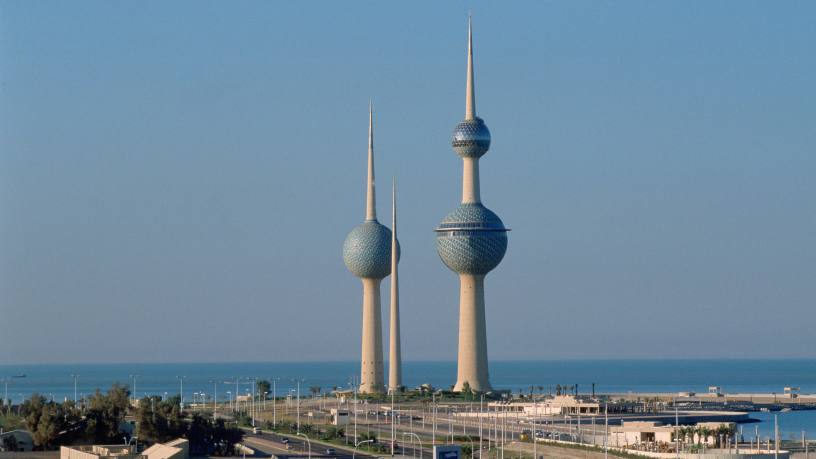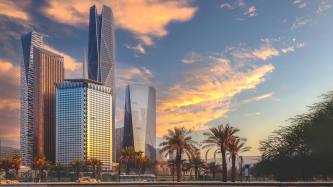At a glance
- GDP shrank by 0.7 per cent in 2023 on lower oil prices and production
- 2023/24 deficit is the ninth in 10 years amid bloated public spending
- February dissolution of parliament prompts fifth general election in 10 years
After reaping the benefits of surging oil prices in the immediate wake of Russia’s invasion of Ukraine, Kuwaiti finances reverted to the mean in 2023, as lower prices and production dragged its economy back into the doldrums.
With a contraction in gross domestic product in 2023 set to be followed by a further decline this year, the country remains hamstrung by a fractious political environment and stalled reform agenda that continues to hold back its long-term development goals.
While its neighbours in the Gulf Cooperation Council have begun to make strides in diversifying away from a reliance on hydrocarbons, Kuwait’s economic fortunes remain tied to the vagaries of the international oil market, with crude revenues accounting for around half of GDP and approximately 90 per cent of government export revenue.
As one of the world’s top 10 exporters, the country was one of the main beneficiaries of the surge in prices in 2022, with GDP growth surging by 8.9 per cent.
Yet revenues slid back sharply in 2023 as prices eased and the country implemented a production cut of 128,000 barrels a day from May under an agreement with Opec+ (a group comprising the Organisation of the Petroleum Exporting Countries, along with 10 other major oil-producing countries). The bloc agreed further cuts in March in an effort to support prices, with Kuwait trimming a further 135,000 barrels of daily production.
The National Bank of Kuwait, the country’s largest lender, estimates real GDP shrank by 0.7 per cent last year, roughly in line with IMF projections, with NBK forecasting a further contraction of 0.2 per cent this year.
Farah ElRafei, a senior economist with Oxford Economics, anticipates that last year’s weakened domestic demand and fall in oil activities will weigh on the economy in the coming months.
“The economy is likely to soften [in 2024] due to lower oil output, a slowdown in consumer spending, political gridlock and delayed reforms,” ElRafei tells The Banker.
Political gridlock
The country’s challenges — a reliance on oil revenues, a ballooning public sector and over-generous subsidies — have been apparent for decades. Yet economic reform continues to be held back by the country’s dysfunctional political system, characterised by standoffs over reforms between elected members of the National Assembly and cabinet members appointed by the country’s ruling family.
Following the death of the country’s emir Nawaf al-Ahmad al-Jaber al-Sabah in December, the accession of his successor, Mishal al-Ahmad al-Jaber al-Sabah, came with the promise of a revamped political agenda, prioritising “transparency” and “government accountability”, according to his first speech before the National Assembly that month.
January saw the appointment by the new emir of a well-regarded and technocratic prime minister, Mohammad Sabah al-Salem al-Sabah, to lead a new government. The new prime minister in February pitched an action plan to address “imbalances” in the economy, including generous subsidies and a bloated public sector.
But following accusations of “constitutional violations” by members of the National Assembly, reportedly including insults against the emir, the representative body was dissolved later that month, plunging Kuwait back into political paralysis. Fresh general elections, the fifth in 10 years, are scheduled for April 4, with optimism for reforms under the new emir fading fast.
“There was hope that a new emir, a dynamic prime minister, and increasing fiscal stress would bring the country to a decision point regarding its reform agenda,” says Robert Beschel, a non-resident senior fellow at the Middle East Council on Global Affairs.
Instead, Beschel reckons Kuwait is at risk of “slipping into a structural deficit given that its revenues are volatile, whereas its expenditures are consistently trending upwards”.
The longer-term prospects remain bleak: rising US shale oil output, coupled with the global green energy push, is contributing to an uncertain oil price outlook, and fuelling concerns over the sustainability of Kuwait’s fiscal stance.
Kuwait is expected to record a deficit of Kd6.8bn ($22.1bn) for the fiscal year 2023/24, its ninth fiscal deficit of the past 10 years, with the oil price surge-boosted surplus of 2022/23 the sole exception. The country’s draft budget for 2024/25 (beginning on April 1) envisages a lower deficit of Kd5.9bn, thanks to a drop in one-off expenditures.
“Absent fresh debt issuance or other measures, the squeeze on the government’s liquid reserves will continue to grow,” said NBK in a note.
One of the most glaring symbols of the country’s economic challenges is the absence of a public debt law for the past seven years, leaving the country unable to tap international markets to plug public spending gaps like its regional peers.
Following the expiration of public debt legislation in 2017, successive parliaments have failed to pass a permanent law enabling the country to issue debt.
Ali H. Khalil, chief executive of asset management firm Kuwait Financial Centre, or Markaz, notes that Kuwait’s gross debt-to-GDP remains low — just 3.3 per cent of GDP according to the IMF — making the use of debt capital an easy solution.
Beyond a new debt law, tackling the country’s bloated wage and subsidy bill, which accounts for 79.4 per cent of all budget expenditures, remains a key priority.
“Kuwait already has the largest civil service in the GCC and one of the largest public sectors worldwide,” says Beschel.
An expanding working-age Kuwaiti population, which has grown up against a backdrop of a social and political contract of which the public sector is a key part, threatens to undermine this goal. The IMF estimates 100,000 young Kuwaitis will enter the workforce over the next five years, heaping pressure on already-strained government finances.
“Over the next 10 to 15 years, the country is experiencing a demographic bulge, and many young Kuwaitis will enter the workforce and expect a job in the public sector. So, there's going to be very significant pressure on the government,” says Beschel.
Yet meaningful structural reforms, including steps to incentivise young Kuwaitis to pursue private sector careers, will require “broad consultation with private stakeholders, parliament and the public to secure sustained social support”, according to the IMF in its most recent Article IV consultation in September.
Other steps to shore up Kuwait’s public finances in the coming years could include a range of revenue mobilisation measures, such as the introduction of corporate income tax, excise duties on certain goods, and value added tax.
“The government is considering implementing corporate and excise taxes as part of its medium-term revenue mobilisation strategy. This move aims to establish a comprehensive fiscal framework to tackle key economic challenges,” says Khalil.
Such changes, once again, are subject to finding a way through the long-standing political gridlock between the parliament and government.
China’s influence
Like its neighbours in the GCC, Kuwait is seeking greater foreign investment to stimulate non-oil growth and become a key business and trade hub for the upper Gulf region. China is one of the country’s key partners in this plan, and is actively involved in several of Kuwait’s largest infrastructure and development projects.
In September 2023, the two countries signed co-operation agreements covering infrastructure, free trade zones and renewable energy. A memorandum of understanding covering Kuwait’s massive Mubarak Al-Kabeer seaport was also agreed. The port is being developed under the auspices of China’s Belt and Road Initiative (Kuwait was the first regional signatory of BRI “co-operation documents” with Beijing) as part of an initial phase of Kuwait’s larger Silk City megaproject.
“China views its relationship with Kuwait as strategically important, particularly in the Belt and Road Initiative context. Kuwait is a key partner for China in the Persian Gulf region, offering opportunities for co-operation in various sectors [of the economy],” says Mordechai Chaziza, senior lecturer in the department of politics and governance at Ashkelon Academic College and an expert in China-GCC relations.
“Kuwait’s strategic location along maritime trade routes further enhances its importance to China’s broader geopolitical and economic interests in the region,” he adds.
Beyond hard infrastructure, Chaziza’s research has identified growing Chinese investments in Kuwait’s digital technology base.
Huawei has been active in the country, installing more than 1000 5G sites nationwide and receiving approval to offer cloud computing services, pointing to Beijing’s growing role across all sectors of the Kuwaiti economy.
Kuwait’s inward net foreign direct investment inflows increased from $240mn in 2020 to $758mn in 2022, according to Unctad, reflecting greater interest from China and other bilateral partners. Yet such figures remain paltry even by GCC standards, representing just 0.4 per cent of GDP, compared with 0.7 per cent for Saudi Arabia and 4.5 per cent for the UAE.












